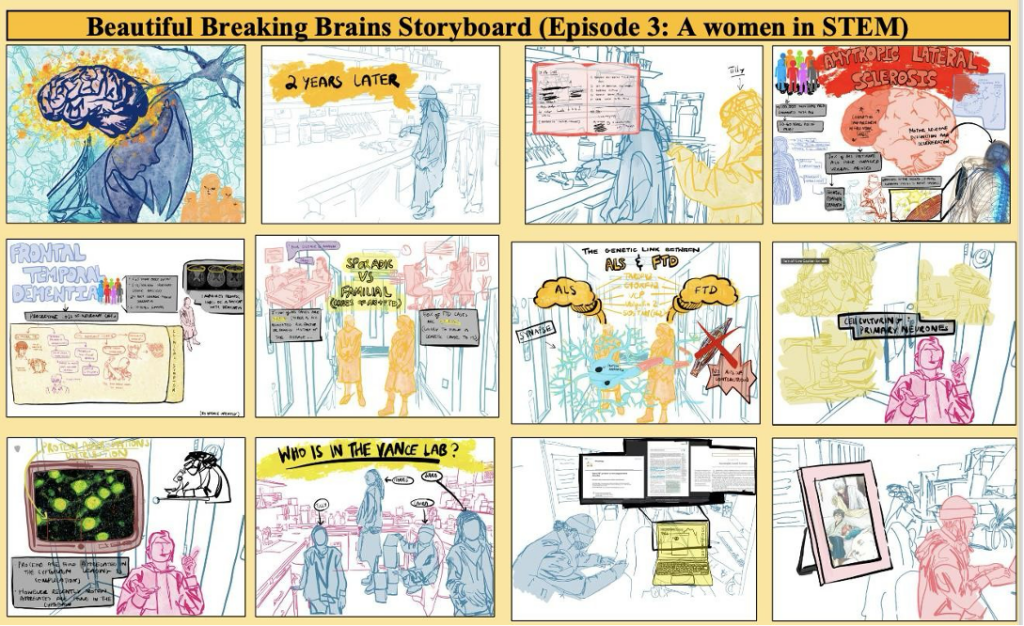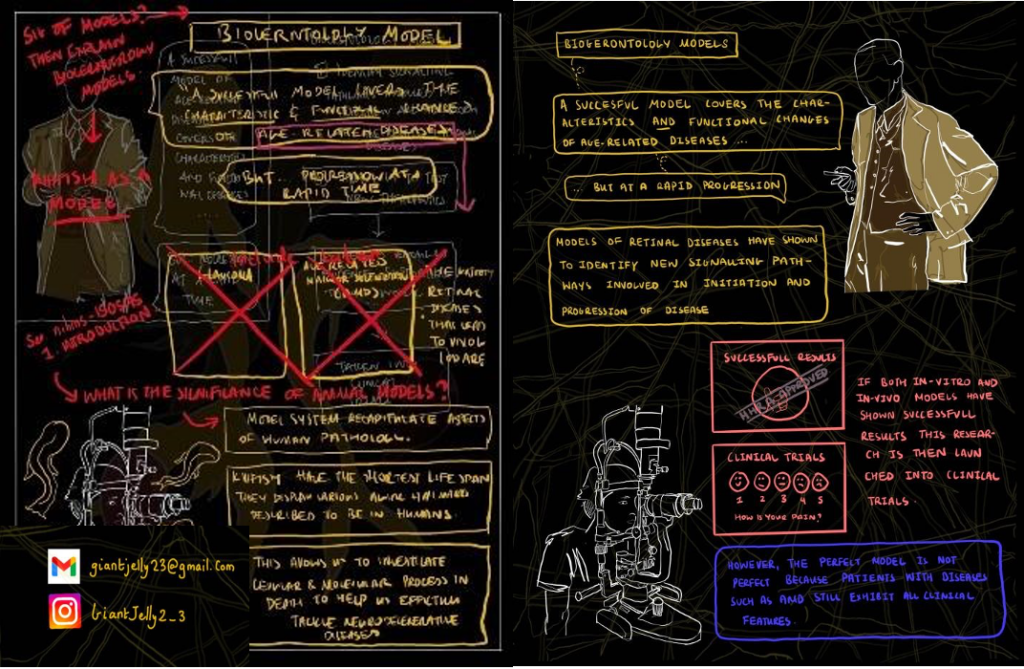By Hiba Noor
My name is Hiba Noor, and this is my story.
I am a Biomedical Undergraduate who has interned at In2scienceUK
Something I dreaded was to sit an exam because I was not very good at it. Furthermore, I was a first-generation STEM student in my family. This was a journey in which I have learnt many things and that has not stopped. I spent a lot of time trying to memorise knowledge using textbooks, flashcards, and study notes. I also visualised my lecture notes by drawing diagrams and using coloured felt-tip pens to study. I noticed that this was a method of consolidating my lectures because it helped me solidify my learned scientific knowledge.
Follow gixntjelly and discover her work
Jim Al-Khalili says:

I consider myself a visual learner. My favourite thing about visual learning is to satisfy my crave for knowledge. I love to look at a visual comparison of the size of planets in our solar system, that intrigued me more than text and helped me understand it. So, looking at science encyclopaedias that were filled with rich-coloured images stuck with me longer. The illustrations of a digestive system would initially grab my attention and further sparked my imagination to visualise it in my mind. Even the images science produces (microscopic images) would confuse me – even as a graduate, but when an illustration was made about it, I find myself grasping the understanding of the results in front of me.
My undergraduate degree was unfortunately at the time when COVID-19 locked us down. The social distancing laws infringed on my laboratory time. So, I was left with limited choices such as science communication. At first, this felt like a negative impact on my university experience but as my awareness grew in the importance of science communication. I understood that I could share science in an interesting way, my way.

My first communicative science piece was a storyboard explaining the relationship between amyotrophic lateral sclerosis (ALS) and Frontal Temporal Dementia (FTD), in Kings College, my module organisers and supervisors were Dr Leigh Wilson, Professor Richard Wingate and Dr Caroline Vance.
After graduating from Biomedical science, I produced my first comic called ‘It all Matters’ which tells the story of a young mother studying for her PhD. This was inspired by the amazing supervisors I had worked with at UKDRI Dr Emma Clayton and Dr Sarah Mizielinska. However, my experience and opportunities were cut short because I had already graduated. I searched for months for an internship opportunity, and I came across the yearlong In2scienceUK programme.

I enjoyed watching cartoons throughout my childhood, this translated into comics as a teenager and anime as a young adult. This included Scooby-Doo, the amazing world of Gumball, Ed, Edd and Eddy. The style of art here is very comical and cartoon-like. The amazing world of Gumball incorporates human-like animals e.g. rabbits, a cat with soft pastel colours. What makes this cartoon so unique is the facial expression the artist uses to express the characters. More recently I have been fascinated by anime. Anime is Japanese-derived. What makes them unique is the process of creating such detailed animation using manga scripts, line art drawings and hundreds of manuscript edits. Anime embraces Japanese culture to narrate stories which makes them their only kind. Every artist uses a well-thought-out storyline, and they never fail to surprise me.
I have watched 100+ animes, and one of my favourite anime is Mob-Pysco 100. I particularly enjoy the black background it uses alongside a rainbow of colours to capture the watch’s attention. The bright neon colours merged with the bold cyber-punk texts really set what story the author ONE is trying to tell. This was without even having to read the anime description. In addition to this, the moulding of each character in mob psycho is very plain and boring but despite that the details ONE puts into the outline and their superpowers bring life to them. This is further enhanced with the colours and bold text.

Comics and Manga are hand-drawn versions of cartoons and anime. Prior to technology, most artists would narrate stories through hand drawings. This would then be printed and distributed to bookshops, corner shops, libraries and newspaper stands. I appreciate how every artist can use traditional techniques such as pencils or acrylic paint to bring to life backgrounds, and hand/body language to depict actions through still images. A lot of trialed sketches were attempted resulting in practice and techniques about art shared within the artistic community. Hence, I must appreciate and respect original illustrations and art.
My work
With the rise of technology, I wanted to translate my skills onto a digital platform. I did this through a software on my iPad Pro called Procreate. This meant I was free to undo my mistakes without having to destroy my art however it also meant the process of creation would be lost. Although most digital software now offers video playbacks to track the process of drawing. Digital art is more accessible, there’s a lot of flexibility with what every programme offers, including Pro-Create and Adobe Illustrator. It produces high-quality and refined images – something that traditional artists find difficult to obtain. Digital art can be easily printed and adjusted to canvas size.
My characters have a sense of realism to them because I wanted to highlight the information in the comic rather than the characters. In this comic, I embodied scientists with speech bubbles because they personalise the text engaging the reader. It also chronologically orders the heavy scientific information to help the reader feel less overwhelmed with technical terms. I found having a character guide me through a book was more effective than having to figure the order out myself. So, I took this into perspective and did the same for this comic.
I am fond of bright colours and after experimenting with previous illustrations and comics, a black background adds contrast to colours. It enhanced the scientific diagrams I drew and brought the comic to life. I received a lot of positive feedback, bringing it a lot of attention to potential readers. This is something that inspired me while watching Mob Psycho 100 and The Amazing World of Gumball.
The purpose of the comic was for my non-scientific audience to understand my poster. My comic has very few technical terms, so they do not have to have prior scientific knowledge to understand my poster presentation – this is what the comic does. I also had to research the general knowledge on animal models etc, doing so gave me a general idea of what to include in the comic. Together, I ordered the significance of the content and created a rough template of how to structure my comic. It looked like this:

My Challenges
The biggest challenge I’ve had was trying to balance work full-time and illustrating science. Coming home from work exhausted after a 10-hour shift to do a little bit of illustration was not easy. The deadlines I set myself had me up for long nights, this was when I realised how much I love sweet coffee. What motivated me to stay consistent was the new science knowledge I was learning about, it made me miss university (shocking!).
More often I would find myself experiencing an artist block. I had difficulties trying to understand how to incorporate a scientific message using a story because the idea is novel, which meant there was very limited resources to refer/reflect on. I visited exhibitions and comic studios to gain insight. With one of them being the New Scientist Live 2023 event. From this, I learned a lot of the activities were interactive and I tried to do something similar in my comic. The challenge of inspiration itself. It did not come as you would think, it took time and experience. Trial and error paired with a determination to ultimately make this science interesting and memorable was the driver to my achievements.
After producing the first copy of my work and having it printed out for my audience to see, I doubted the quality of my work. I sought to get the opinion of the general audience who were very positive of my work but suggested various lines of improvement including larger text, larger picture etc. This led me to touch up my comic and produce a refined version. The doubt I had for my comic was difficult to overcome however the support from my supervisors, family and friends made me realise my potential. Having this made me want to do more and do better.
My Insight
There are not many illustrative science communication pieces out there, especially comics. A comic illustrating animals attracted a positive response, it gave me more confidence to expand in this field of science communication. I strive for my comic to be scientifically accurate and illustrate them in an artistic way. I will continue to work on scientific comics and I hope it will raise awareness in science and interest the young generations to be as intrigued as I was in understanding what is inside and around us.
I plan on expanding on this and even creating a learning platform where I can facilitate the reaching of this goal. Currently, I am an affiliate artist at Zeeks for Geeks. The organisation enables me to come across likeminded people and potential clients who would benefit from this form of work.
In2science is an internship program that supports a wide range of participants, from all backgrounds an opportunity to research a topic and produce results to present as a poster presentation at the end of the year. This helps students prepare for the industry or academia. Most internship programmes are offered to Year 12 students. In2science was the only unique programme offered to tailor my scientific needs because it provided a graduate like me the opportunity to enhance my knowledge in neuroscience despite my immunology background.
The In2science programme is growing every year. In 2021 they had 25 students but now they are now looking to take on 125 students this year. I took part in an 8-week internship in we which researched characterising the African Turquoise Killifish retina. I produced a poster and a comic, both of which I illustrated myself. I knew I had to make the most of this 8-week opportunity and dive into something I was very passionate about. I designed an informative science comic targeted towards a non-scientific audience. This is my most recent comic Institute of Ophthalmology.
Institute of Ophthalmology is an informative comic which narrates the science research carried out at Moorfield Eye Hospital research facility. I worked with Dr Nicole Noel and Nicole Chiu to characterise the African Turquoise Killifish retina, verify antibodies, and examine optimal protocol. The study was novel because the animal model was novel. Due to the shorter life span of the killifish. This allowed us to observe the ageing of the retina quicker if it was efficient and sustainable then results could be produced quicker compared to the zebrafish where we would have to wait 2-3 years. Hence the purpose of our research. We explored the underlying mechanism behind visual transduction and the significance of photoreceptors. Followed by a basic introduction to two main experimental techniques: In-situ hybridisation (HCR) and Immunohistochemistry (IHC)

